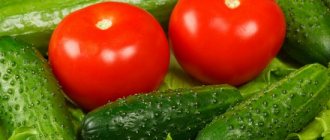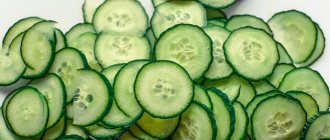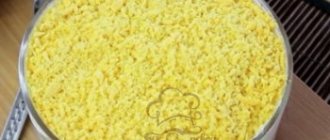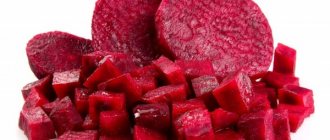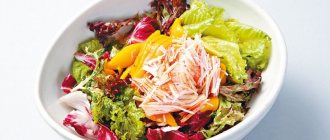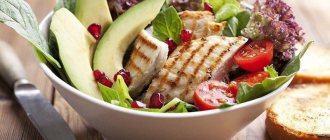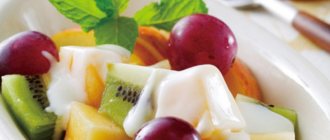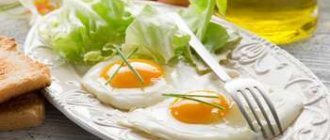Salads made from vegetables are invariably popular with professional chefs and ordinary housewives.
All of us know that any vegetable is tasty and healthy. And the salad, unless, of course, you pour a lot of sour cream or mayonnaise into it, contains a minimum of calories. That is why a considerable number of cookbooks are devoted to dietary varieties of this dish. Let's analyze the composition and calorie content of some common vegetable salad recipes and make sure that many of them should be included in our daily menu as often as possible.
A fresh vegetable salad
Calorie content – 24 kcal, BJU:
- Proteins – 1.4 g
- Fats – 0.3 g
- Carbohydrates – 4.1 g
Salad ingredients
- Tomatoes – 2 pcs.
- Cucumber – 1 pc.
- Sweet pepper – 1 pc.
- Salad mix – 30 g
- Salt - to taste
- Spices - optional
- Yogurt – 40 ml
>Cooking
Salad with crab sticks
Calorie content – 105.1 kcal, BJU:
- Proteins – 4.1 g
- Fat – 6.4 g
- Carbohydrates – 7.3 g
Ingredients
- Chicken eggs – 2 pcs.
- Crab sticks – 100 g
- Canned corn – 100 g
- Fresh cucumber – 1 pc.
- Boiled rice – 4 tbsp. l.
- Salt – 2 pinches
- Spices - to taste
- Mayonnaise – 2 tbsp. l.
>Cooking
Calorie content of vegetables
Vegetables are an ideal option for a diet. It is not for nothing that they often form the basis of the diet of those who strive to get their body in good shape. A huge variety of vegetables allows you to plan your diet in such a way that the same dish will not be repeated throughout the week. Eating fresh vegetables will saturate the body with essential vitamins, macro- and microelements, dietary fiber and healthy acids. Most fruits are extremely effective in losing weight and have a lot of qualities and properties that improve the functioning of the body during the diet. Finally, the caloric content of vegetables is very low, which allows you to eat them in large quantities and prevent the feeling of hunger .
Caesar salad
Calorie content – 121 kcal, BJU:
- Proteins – 9.4 g
- Fat – 7.9 g
- Carbohydrates – 2.8 g
Ingredients
- Chicken meat – 120 g
- Iceberg salad – 40 g
- Mustard – 1 tsp.
- Yogurt – 3 tbsp. l.
- Garlic – 2 cloves
- Salt - to taste
- Spices - to taste
- Chicken eggs – 1 pc.
- Cherry tomatoes – 50 g
- Hard cheese – 20 g
- Lemon – 1 slice
>Cooking
Recipe for vegetable salad without dressing. Calorie, chemical composition and nutritional value.
Nutritional value and chemical composition of “Vegetable salad without dressing.”
The table shows the nutritional content (calories, proteins, fats, carbohydrates, vitamins and minerals) per 100 grams of edible portion.
| Nutrient | Quantity | Norm** | % of the norm in 100 g | % of the norm in 100 kcal | 100% normal |
| Calorie content | 14.3 kcal | 1684 kcal | 0.8% | 5.6% | 11776 g |
| Squirrels | 0.9 g | 76 g | 1.2% | 8.4% | 8444 g |
| Fats | 0.1 g | 56 g | 0.2% | 1.4% | 56000 g |
| Carbohydrates | 2.8 g | 219 g | 1.3% | 9.1% | 7821 g |
| Organic acids | 0.2 g | ~ | |||
| Alimentary fiber | 0.7 g | 20 g | 3.5% | 24.5% | 2857 g |
| Water | 94.8 g | 2273 g | 4.2% | 29.4% | 2398 g |
| Ash | 0.652 g | ~ | |||
| Vitamins | |||||
| Vitamin A, RE | 106.4 mcg | 900 mcg | 11.8% | 82.5% | 846 g |
| beta carotene | 0.639 mg | 5 mg | 12.8% | 89.5% | 782 g |
| Vitamin B1, thiamine | 0.034 mg | 1.5 mg | 2.3% | 16.1% | 4412 g |
| Vitamin B2, riboflavin | 0.032 mg | 1.8 mg | 1.8% | 12.6% | 5625 g |
| Vitamin B4, choline | 5.1 mg | 500 mg | 1% | 7% | 9804 g |
| Vitamin B5, pantothenic | 0.136 mg | 5 mg | 2.7% | 18.9% | 3676 g |
| Vitamin B6, pyridoxine | 0.045 mg | 2 mg | 2.3% | 16.1% | 4444 g |
| Vitamin B9, folates | 9.086 mcg | 400 mcg | 2.3% | 16.1% | 4402 g |
| Vitamin C, ascorbic acid | 13.9 mg | 90 mg | 15.4% | 107.7% | 647 g |
| Vitamin E, alpha tocopherol, TE | 0.214 mg | 15 mg | 1.4% | 9.8% | 7009 g |
| Vitamin H, biotin | 0.531 mcg | 50 mcg | 1.1% | 7.7% | 9416 g |
| Vitamin K, phylloquinone | 66.2 mcg | 120 mcg | 55.2% | 386% | 181 g |
| Vitamin RR, NE | 0.4821 mg | 20 mg | 2.4% | 16.8% | 4149 g |
| Niacin | 0.377 mg | ~ | |||
| Macronutrients | |||||
| Potassium, K | 233.33 mg | 2500 mg | 9.3% | 65% | 1071 g |
| Calcium, Ca | 31.26 mg | 1000 mg | 3.1% | 21.7% | 3199 g |
| Silicon, Si | 28.752 mg | 30 mg | 95.8% | 669.9% | 104 g |
| Magnesium, Mg | 15.12 mg | 400 mg | 3.8% | 26.6% | 2646 g |
| Sodium, Na | 11.48 mg | 1300 mg | 0.9% | 6.3% | 11324 g |
| Sera, S | 10.82 mg | 1000 mg | 1.1% | 7.7% | 9242 g |
| Phosphorus, P | 35.3 mg | 800 mg | 4.4% | 30.8% | 2266 g |
| Chlorine, Cl | 43.2 mg | 2300 mg | 1.9% | 13.3% | 5324 g |
| Microelements | |||||
| Aluminium, Al | 331 mcg | ~ | |||
| Bor, B | 53.8 mcg | ~ | |||
| Vanadium, V | 21.21 mcg | ~ | |||
| Iron, Fe | 0.571 mg | 18 mg | 3.2% | 22.4% | 3152 g |
| Yod, I | 1.87 mcg | 150 mcg | 1.2% | 8.4% | 8021 g |
| Cobalt, Co | 3.274 mcg | 10 mcg | 32.7% | 228.7% | 305 g |
| Lithium, Li | 15.667 mcg | ~ | |||
| Manganese, Mn | 0.1572 mg | 2 mg | 7.9% | 55.2% | 1272 g |
| Copper, Cu | 80.12 mcg | 1000 mcg | 8% | 55.9% | 1248 g |
| Molybdenum, Mo | 4.224 mcg | 70 mcg | 6% | 42% | 1657 g |
| Nickel, Ni | 5.617 mcg | ~ | |||
| Rubidium, Rb | 74.1 mcg | ~ | |||
| Selenium, Se | 0.424 mcg | 55 mcg | 0.8% | 5.6% | 12972 g |
| Strontium, Sr | 3.37 mcg | ~ | |||
| Fluorine, F | 17 mcg | 4000 mcg | 0.4% | 2.8% | 23529 g |
| Chromium, Cr | 3.58 mcg | 50 mcg | 7.2% | 50.3% | 1397 g |
| Zinc, Zn | 0.246 mg | 12 mg | 2.1% | 14.7% | 4878 g |
| Zirconium, Zr | 1.71 mcg | ~ | |||
| Digestible carbohydrates | |||||
| Starch and dextrins | 0.126 g | ~ | |||
| Mono- and disaccharides (sugars) | 2.4 g | max 100 g | |||
| Essential amino acids | 0.058 g | ~ | |||
| Valin | 0.009 g | ~ | |||
| Histidine* | 0.003 g | ~ | |||
| Isoleucine | 0.006 g | ~ | |||
| Leucine | 0.008 g | ~ | |||
| Lysine | 0.012 g | ~ | |||
| Methionine | 0.004 g | ~ | |||
| Methionine + Cysteine | 0.006 g | ~ | |||
| Threonine | 0.008 g | ~ | |||
| Tryptophan | 0.002 g | ~ | |||
| Phenylalanine | 0.008 g | ~ | |||
| Phenylalanine+Tyrosine | 0.012 g | ~ | |||
| Nonessential amino acids | |||||
| Tyrosine | 0.004 g | ~ | |||
| Cysteine | 0.002 g | ~ |
The energy value of vegetable salad without dressing is 14.3 kcal.
Primary Source: Created in the application by the user. Read more.
** This table shows the average levels of vitamins and minerals for an adult. If you want to know the norms taking into account your gender, age and other factors, then use the “My Healthy Diet” application.
Olivier in the shape of a turtle
Calorie content – 164 kcal, BJU:
- Proteins – 6.8 g
- Fat – 12.9 g
- Carbohydrates – 4.9 g
Ingredients
- Boiled sausage – 250 g
- Fresh cucumber – 1 pc.
- Chicken eggs – 2 pcs.
- Potatoes – 2 pcs.
- Pickled cucumber – 1 pc.
- Mayonnaise – 50 ml
- Salt - to taste
- Ham – 3 slices
>Cooking
Olivier with three types of cucumbers
Calorie content – 126 kcal, BJU:
- Proteins – 5.5 g
- Fat – 8.9 g
- Carbohydrates – 6.1 g
Ingredients
- Chicken eggs – 3 pcs.
- Canned peas – 150 g
- Potatoes – 3 pcs.
- Fresh cucumber – 1 pc.
- Pickled cucumber – 1 pc.
- Pickled cucumber – 1 pc.
- Carrots – 2 pcs.
- Boiled sausage – 300 g
- Mayonnaise – 60 ml
- Salt - to taste
>Cooking
Herring under a fur coat with tuna
Calorie content – 102.6 kcal, BJU:
- Proteins – 5.7 g
- Fat – 5.4 g
- Carbohydrates – 7.8 g
Ingredients
- Potatoes – 2 pcs.
- Canned tuna – 100 g
- Lightly salted herring – 70 g
- Carrots – 2 pcs.
- Beets – 2 pcs.
- Chicken eggs – 2 pcs.
- Onion – 1 pc.
- Mayonnaise – 50 ml
- Greens for decoration
>Cooking
Benefits and calorie content of vegetables
Vegetables are record holders for the amount of fiber, fiber and complex carbohydrates. It is the word “carbohydrates” in vegetables that sometimes scares away those losing weight. On the one hand, carbohydrates are the most nutritious nutrient after fats, and as a result the most dangerous, since they are relatively easily deposited in the most unnecessary places. However, this is only part of the information, which mostly concerns simple carbohydrates. Complex carbohydrates, which include starch, glycogen, cellulose, take longer to digest, cause less insulin release into the blood, and therefore are almost not converted by the body into fat deposits. Vegetables owe all their already low calorie content to the content of complex carbohydrates.
To understand what benefits each vegetable brings, you need to determine the types of complex saccharides that make up them.
Soluble dietary fiber is found in peas and beans. Calorie content of vegetables in 100 grams, respectively: 55 kcal and 16 kcal . When these fibers enter the intestines, they are converted into a gel, which, by preventing the rapid movement of food through the intestines, slows down the absorption of carbohydrates. Some pectins, also a type of soluble fiber, reduce the absorption of sugar and fat in the intestine and lower cholesterol concentrations. Calorie content of vegetables that contain pectin: carrots - 35 kcal per 100 g, cauliflower - 30 kcal, potatoes - 77 kcal.
Greek salad
Calorie content – 90.6 kcal, BJU
- Proteins – 2.5 g
- Fat – 7.1 g
- Carbohydrates – 3.5 g
Greek salad ingredients
- Cucumber – 1 pc.
- Tomatoes – 2 pcs.
- Sweet pepper – 1 pc.
- Salad mix – 30 g
- Olives – 30 g
- Feta cheese – 50 g
- Salt - to taste
- Spices - to taste
- Olive oil – 25 ml
>Cooking
Calorie content of vegetable salads in different versions
The components of vegetable salads, of course, are vegetables. The energy value of such snacks ranges from twenty to one hundred and forty kilocalories. Salads with potatoes and asparagus have higher calorie content.
As you can see, this treat does not harm our figure and can be safely included in the diet menu.
On a note! Vegetables are a real storehouse of valuable vitamins and minerals that strengthen our body.
Let's look at the calorie content of the most popular types of vegetable snacks:
- A vegetable salad-cocktail contains one hundred and forty-seven kilocalories.
- A snack based on apples and radishes contains one hundred and fifty-seven kilocalories.
- A salad with apples and bell peppers will contain one hundred and twenty-three kilocalories.
- A salad based on cauliflower, cucumbers and fresh tomatoes brings us seventy-eight kilocalories.
- A mixed vegetable appetizer contains ninety-four kilocalories in its raw form.
- If you add asparagus to the appetizer, it will contain two hundred thirty-seven kilocalories.
- A salad with turnips contains one hundred and forty-two kilocalories.
- The energy value of a salad with radish and potatoes in Kabardian style is one hundred twenty-eight units.
- A radish salad with sour cream dressing contains one hundred and six kilocalories.
- Everyone's favorite salad of tomatoes, peppers and cucumbers brings us only twenty-five kilocalories.
- A Chilean tomato appetizer contains twenty kilocalories.
- A traditional salad of cucumbers and tomatoes gives us ninety kilocalories.
- An appetizer of assorted vegetables with the addition of sea cabbage contains one hundred and thirty-seven kilocalories.
- A salad based on rice with the addition of bell peppers and peas contains two hundred and forty-eight kilocalories.
- A salad with zucchini and tomatoes will contain one hundred and three kilocalories.
- “Greek” salad contains one hundred eighty-nine kilocalories.
- A pea snack with apples gives us one hundred and two kilocalories.
- Radishes with sour cream dressing contain one hundred and three kilocalories.
- An appetizer of tomatoes with garlic sauce has a caloric value of seventy units.
- Tomatoes with apples and cucumbers contain seventy-one kilocalories.
- The Korean asparagus appetizer contains one hundred and fourteen kilocalories.
- A green salad with tomatoes and eggs will contain fifty-three kilocalories.
On a note! For salads, choose juicy vegetables. They have a lot of liquid component, which means fewer calories.
The energy value of vegetable salad is significantly influenced by the dressing. How many calories are in vegetable salad with mayonnaise? This figure is equal to forty-five kilocalories. Choose low-fat mayonnaise if you are following a diet menu.
How many calories are in a vegetable salad with sour cream? This snack will contain approximately thirty kilocalories. You can reduce the calorie content of the salad by using yogurt for dressing. This dish contains twenty-nine kilocalories.
How many calories are in a vegetable salad with butter depends on the type of product. If you season the snack with olive oil, it will contain sixty kilocalories. And when using purified vegetable oil, this figure is equal to fifty-five kilocalories.
On a note! Are you afraid of extra pounds? Pay attention to how many calories are in a vegetable salad without oil. This treat contains only seventeen kilocalories.
Salad with chicken and prunes
Calorie content – 150.7 kcal, BJU:
- Proteins – 11.0 g
- Fat – 8.0 g
- Carbohydrates – 8.7 g
Ingredients
- Chicken fillet – 140 g
- Chicken eggs – 2 pcs.
- Dried prunes – 60 g
- Walnuts – 40 g
- Cucumber – 1 pc.
- Yogurt – 70 ml
- Salt - to taste
>Cooking
Korean carrots
Calorie content – 93 kcal, BJU:
- Proteins – 1.2 g
- Fat – 5.2 g
- Carbohydrates – 10.8 g
Ingredients
- Carrots – 500 g
- Sugar – 1 tbsp. l.
- Salt – ½ tsp.
- Spices – ½ tsp.
- Garlic – 2 cloves
- Vegetable oil – 3 tbsp. l.
- Apple cider vinegar – 1 tbsp. l.
>Cooking
Vegetable salad with feta cheese
Calorie content – 119.6 kcal, BJU:
- Proteins – 3.6 g
- Fat – 10.6 g
- Carbohydrates – 2.1 g
Ingredients
- Tomatoes – 1 pc.
- Cucumber – 1 pc.
- Cheese cheese – 100 g
- Spinach – 30 g
- Iceberg – 30 g
- Parsley – 3 sprigs
- Salt – 1 pinch
- Spices – 1 pinch
- Vegetable oil – 30 ml
>Cooking
How many calories are in home-cooked vegetables?
Due to their low calorie content, vegetables are suitable for any type of preparation . They can be boiled, baked, steamed, stewed and even fried. The last cooking method is the least recommended because it is the most high-calorie. And no matter how many calories there are in a vegetable, when fried, this amount triples.
It was found that stewing is the ideal way to cook vegetables. Firstly, this preserves the maximum vitamins, appearance and rich taste of vegetables. Secondly, the calorie content of stewed vegetables is slightly higher than the calorie content of fresh ones, but remains low, and their use will not affect the shape.
Vegetables should be stewed without oil. You can eliminate the blandness by adding a little salt, black pepper, and lean meat. The result is a hearty and dietary stew.
All vegetables are suitable for stewing; calorie content does not matter . The only exception would probably be potatoes. Compared to the general background, it looks too nutritious.
Calorie content of stewed vegetables:
- eggplant – 60 kcal per 100 g;
- carrots – 32 kcal per 100 g;
- green beans – 48 kcal per 100 g;
- zucchini – 48 kcal per 100 g;
- onions – 41 kcal per 100 g;
- cabbage – 43 kcal per 100 g.
Chicken and pineapple salad
Calorie content – 94.8 kcal, BJU:
- Proteins – 6.1 g
- Fat – 4.6 g
- Carbohydrates – 6.9 g
Salad ingredients
- Canned corn – 70 g
- Beijing cabbage – 30 g
- Chicken meat – 100 g
- Canned pineapple – 80 g
- Yogurt – 45 ml
- Salt - to taste
- Spices - to taste
>Cooking
Option with green peas and beets
We advise lovers of dietary dishes to pay special attention to another very interesting recipe for vegetable salad seasoned with vegetable oil. You can see a photo of such a dish a little later, but now let’s figure out what is needed to prepare it. This snack includes:
- 300 grams of beets.
- Medium bulb.
- 300 grams of carrots.
- 200 g pickled cucumbers.
- 400 grams of potatoes.
- 400 g green peas (canned).
- Vegetable oil, any fresh herbs and salt.
Root vegetables are rinsed under the tap, placed in different saucepans, filled with cool water, brought to a boil and boiled until soft. The prepared vegetables are cooled to room temperature, peeled, cut into approximately equal cubes and combined in a deep salad bowl. Green peas, finely chopped onion and pieces of pickled cucumber are also placed there. All this is salted and poured with vegetable oil. The finished snack, the energy value of which is 62.8 kcal/100 g, is decorated with chopped herbs and served for lunch.
Green tomato salad for the winter
Calorie content – 74.8 kcal, BJU:
- Proteins – 1.1 g
- Fat – 5.3 g
- Carbohydrates – 5.9 g
Ingredients
- Green tomatoes – 700 g
- Onions – 2 pcs.
- Garlic – 3 cloves
- Salt – 1.5 tsp.
- Sugar – 1 tsp.
- Spices – ½ tsp.
- Vegetable oil – 50 ml
- Apple cider vinegar – 25 ml
>Cooking
Salad with avocado, chicken and tomatoes
Calorie content – 127.9 kcal, BJU:
- Proteins – 9.1 g
- Fat – 8.5 g
- Carbohydrates – 3.3 g
Ingredients
- Avocado – 1 pc.
- Chicken fillet – 200 g
- Cherry tomatoes – 5-7 pcs.
- Spinach leaves – 30 g
- Soy sauce – 30 ml
- Grated cheese – 2 pinches
>Cooking
Best Recipes
Calorie content of salads in brackets is indicated per 100 g of ready-made dish.
Dietary dressings
With butter
Mix 100 ml of high-quality olive oil (cold-pressed only), 10 ml of apple cider vinegar, squeezed juice from ½ lemon. Reveals the taste of vegetables in a new way.
Italian
Mix 100 ml of Italian olive oil (cold pressed only), 10 ml of wine vinegar, 10 g each of oregano, basil and marjoram (all spices - dry), 1 crushed or grated garlic clove, ground pepper (quantity and type - to taste ). Suitable for green salads.
Aioli
Mix 100 ml of any vegetable oil, juice squeezed from ¼ lemon, 1 hard-boiled yolk mashed with a clove of garlic, ground pepper and any other seasonings (amount to taste). Beat until smooth. The sauce is reminiscent of homemade mayonnaise and perfectly complements poultry and seafood.
After preparation, all dressings should be stored covered in the refrigerator for no more than 1 week.
Protein salads
With Chiken
- "The Little Mermaid" (109 kcal)
Cut into strips 200 g of squid (boiled or canned) and chicken fillet cooked without salt, 1 peeled apple. Place the onion into half rings. Mix all. Season with ground pepper (black/red) and low-fat sour cream.
- "Mercury" (91 kcal)
Place 250 g of chicken breast cooked without salt and 100 g of cucumbers into strips. Roughly chop 150 g of thoroughly washed prunes. Grind 1 onion, 2 egg whites, 50 g boiled champignons. Mix all ingredients. For spices, ground pepper (black/red) is suitable. Season with low-fat sour cream.
- “Ladies' whim” (103 kcal)
Place 200 g of chicken fillet cooked without salt into strips. Cut 100 g canned pineapple into cubes. Grind 1 boiled egg. Crush 4 cloves of garlic. Mix all ingredients. For spices, ground pepper (black / red / mixture) is suitable. Season with unsweetened yoghurt without additives. Top with 50 g of grated hard cheese and a few cranberries.
- “Model” (69 kcal)
Roughly chop 200 g of chicken fillet cooked without salt, 200 g of broccoli scalded with boiling water, 100 g of fresh cucumbers. Mix. No spices required. Any gas station will do.
- “Chicken Bob” (68 kcal)
Roughly chop 100 g of chicken fillet cooked without salt, mix it with 100 g of canned beans. Cut 100 g cherry tomatoes into quarters, chop 1 onion. Mix. Ground pepper (preferably black) is suitable for spices. Fill with any oil. When it comes to garnishing greens, give preference to dill.
With cottage cheese and vegetables (70 kcal)
Recipe for the Dukan Diet. 50 g of fresh cucumbers, straight with peel, are passed through a coarse grater. 50 g celery stalks, cut into pieces. 50 g cherry tomatoes - into halves. Mix the vegetables, add 200 g of coarse-grained low-fat cottage cheese. For the dressing, mix 5 ml of balsamic vinegar, the same amount of olive oil, hot ground pepper (a pinch), chopped onion feathers and parsley.
With tuna (125 kcal)
Coarsely chop 100 g of fresh tomatoes. Place a small onion into half rings, mix them with tomatoes and place on lettuce leaves in the first layer, lightly sprinkling with ground pepper (any kind). Cut 100 g of green beans into halves, after boiling them - this is the second layer. Drain the can of tuna. Mash the fish with a fork (100 g) - place it on top. For dressing, Dijon mustard, olive oil and balsamic vinegar are mixed in arbitrary proportions in a separate container. It is poured from above. The layers do not mix with each other.
Greek dietary (130 kcal)
All ingredients are cut into large cubes: 250 g of boiled chicken fillet, 150 g of fresh vegetables: cucumbers, bell peppers and tomatoes, 100 g of feta cheese. Pitted olives (100 g) are cut into halves. All ingredients are mixed and flavored with an arbitrary amount of oregano and rosemary. Natural olive oil is used as a dressing.
Cleansing
From cabbage
- The famous “Brush” (33 kcal)
Fresh white cabbage is finely chopped and squeezed until the juice is released. Fresh beets and carrots are grated on a coarse grater. All vegetables are mixed in equal quantities. No refueling required.
- From fresh cabbage (65 kcal)
Chop fresh white cabbage and squeeze it with your hands to release abundant juice. Grate fresh beets. Mix them in a ratio of 3 to 1. Fill with oil.
- From Chinese cabbage (98 kcal)
Shred a quarter of the Chinese cabbage. Cut red bell pepper (1 pc.) into strips. Roughly chop 2 blanched tomatoes. Chop a bunch of fresh arugula. Mix everything, sprinkle with lemon juice.
- From broccoli (97 kcal)
Recipe from the Dukan diet for weight loss at the “Alternation” stage. Cut 200 g of broccoli into florets. Place in a bowl over lettuce leaves. Cut 100 g 12% feta cheese into small cubes. Sprinkle them over the cabbage. Pour 100 ml of low-fat yogurt on top and sprinkle with dill. Do not stir.
From carrots
- From carrots and apples (35 kcal)
Both ingredients are passed through a grater in equal quantities. There is no need to peel the apple (just remove the seeds and core). Mix. Leave for half an hour to release the juice - it will become a natural dressing.
- From carrots and beets (30 kcal)
One of the variations of the famous “Brush”, only without cabbage. This salad has a clear advantage: the laxative and diuretic effects are more pronounced, but without bloating and flatulence as side effects. Both fresh vegetables are passed through a grater and mixed in equal quantities. No dressing or seasoning required.
Fat burning
From avocado
- “Tender cherry” (81 kcal)
Cut 10 cherry tomatoes into halves. Peel 1 avocado and cut into small cubes. Chop the basil. Mix. Season with ground black pepper and dry spices to taste. You can season with balsamic vinegar or olive oil.
- “Sports” (92 kcal)
Peel 1 avocado and cut into small cubes. Boil 150 g of peeled shrimp. Cut 50 g of celery (stems) into thin strips. Grind 20 g of leek. Crush a few cloves of garlic (amount to taste). Mix. Pour in 15 ml of wine vinegar. Place in a mound on lettuce leaves. Top with chopped parsley.
- “Light” (96 kcal)
Peel 1 avocado and cut into small cubes. Roughly chop 150 g of tomatoes and cucumbers. Grind 1 onion. Sprinkle with any herbs, season with ground pepper (black / red / mixture). For dressing, take 10 ml olive oil and lemon juice. Mix everything.
From celery
- From stalk celery (103 kcal)
Roughly chop 100 g of tomatoes and celery stalks. Peel ½ ripe avocado and cut into small cubes. Mix. Sprinkle with lime juice.
- From celery root (98 kcal)
Grind 200 g of peeled celery root. Cut 3 bell peppers into strips. Boil 200 g of champignons, put them into thin slices. Crush 5 garlic cloves. Mix. Any ground pepper will do as a spice. Refueling - based on your own preferences.
- From celery and apple (75 kcal)
The recipe is recommended for stage 3 of losing weight on the Dukan diet. Chop fresh white cabbage, squeeze it with your hands to release abundant juice (200 g). Cut celery stalks (150 g), bell pepper (50 g), peeled apples (100 g) into strips. Mix. Sprinkle with lime juice. Sprinkle grated low-fat cheese (no more than 50 g) on top and garnish with parsley.
Fruity (43 kcal)
Cut 4 juicy peaches into quarters, 200 g strawberries into halves. Peel the apple and cut into small cubes. Mix and pour in 150 ml of unsweetened yoghurt.
Turkey salad
Calorie content – 79.2 kcal
- Proteins – 9.9 g
- Fat – 3.4 g
- Carbohydrates – 1.6 g
Ingredients
- Iceberg salad – 30 g
- Turkey – 120 g
- Salt - to taste
- Spices - to taste
- Fresh cucumber – 1 pc.
- Chicken egg – 2 pcs.
- Yogurt – 40 ml
>Cooking
Popular lettuce varieties
The calorie content of lettuce (fresh) is very low, and it contains a great variety of vitamins and microelements. In addition, the bright color and beautiful shape make this product an excellent decoration for any dish. At the moment, the most popular varieties of lettuce are:
- Romaine is the leader among salads. It is a large inflorescence of several green leaves, which is somewhat reminiscent of cabbage. It is most often used in sandwiches or as a garnish.
- Watercress is one of the healthiest of its kind. It has a slight mustard taste, which can be explained by its high content of microelements. This is an excellent option to combat
- Coral gets its name from its distinctive appearance. A light nutty flavor will add an original touch to any dish. And in terms of the amount of calcium and mineral salts, this variety has surpassed all others.
Salad with shrimp
Calorie content – 117.4 kcal, BJU
- Proteins – 8.8 g
- Fat – 8.0 g
- Carbohydrates – 2.6 g
Ingredients
- Shrimp – 150 g
- Vegetable oil – 30 ml
- Salad mix – 30 g
- Tomatoes – 2 pcs.
- Garlic – 2 cloves
- Lime juice – 1 tsp.
- Salt - to taste
- Sesame – ½ tsp.
>Cooking
Salad with couscous and vegetables
Calorie content - 97 kcal, BJU:
- Proteins - 3.5 g
- Fat - 7.2 g
- Carbohydrates - 4.5 g
Ingredients
- Couscous – 2-3 tbsp. l.
- Brie cheese – 50 g
- Salad mix – 30 g
- Tomatoes – 1-2 pcs.
- Radishes – 3-4 pcs.
- Olive oil – 2 tbsp. l.
- Salt - to taste
- Spices – 1 pinch
>Cooking
Salad with Chinese cabbage
Calorie content – 163.6 kcal, BJU:
- Proteins – 9.8 g
- Fat – 13.1 g
- Carbohydrates – 1.2 g
Ingredients
- Beijing cabbage – 50 g
- Cherry tomatoes – 50 g
- Chicken meat – 120 g
- Chicken eggs – 2 pcs.
- Sesame – 1 tsp.
- Vegetable oil – 15 ml
- Lemon juice – 10 ml
- Salt - to taste
>Cooking
Salad with celery, apple and chicken
Calorie content – 117.9 kcal, BJU:
- Proteins – 6.7 g
- Fat – 7.1 g
- Carbohydrates – 6.5 g
Salad ingredients
- Petiole celery – 30 g
- Apple – 1 pc.
- Nuts – 20 g
- Chicken meat – 120 g
- Salt - to taste
- Spices - to taste
- Yogurt – 35 ml
>Cooking
Winter Salad
This dish uses Chinese cabbage, carrots, dried fruits, and apple. All ingredients are seasoned with sour cream.
Composition of ingredients
To prepare the dish you need to buy:
| Compound | Quantity |
| Chinese cabbage | 300 g |
| Apple | 1 PC. |
| Carrot | 1 PC. |
| Lemon juice | 5 ml |
| Dried dates | according to taste preferences |
| Sour cream | 45 g |
Step-by-step cooking process
The dish is prepared step by step:
- Dried fruits must be soaked in boiling water before slicing. After soaking, they need to be drained and chopped into cubes.
- Cabbage should be chopped into strips.
- It is recommended to peel the apple, chop it into strips, and sprinkle it with lemon juice to prevent it from turning black.
- All ingredients need to be combined together in a deep bowl, mixed, seasoned with sour cream.
What can I add?
You can add dried pears, apricots or prunes, and nuts to the dish. You can use fresh pears instead of apples.
How to serve a dish
The product is served cold, garnished with nuts and mint. The dish is more suitable for breakfast and dinner.
Salad with tuna and potatoes
Calorie content – 104 kcal, BJU
- Proteins – 7.2 g
- Fat – 5.3 g
- Carbohydrates – 6.4 g
Salad ingredients
- Potatoes – 2 pcs.
- Canned tuna – 120 g
- Fresh cucumber – 1 pc.
- Chicken eggs – 2 pcs.
- Mayonnaise – 1.5 tbsp. l.
- Salt - to taste
- Spices - to taste
- Fresh herbs - 2-3 sprigs
>Cooking
What are vitamin salads
In order to regularly receive vitamins and fiber, it is advisable to eat vitamin salads at least a little every day.
In the summer-autumn season, we strive to stock up on vitamins so that in the cold the body can fight off any infection and maintain good performance for a long time. You can get a complex of vitamins not only with the help of pharmaceutical products, but also by combining business with pleasure, that is, while eating. So, we know that a large number of useful substances are found in vegetables, herbs, fruits and herbs. And with the help of these products it is quite possible to get enough vitamins for the benefit of the body.
Today, without any unnecessary theory about the benefits of this or that vitamin, we will try to approach the issue practically and study as many salad recipes as possible that can safely be called vitamin-rich. Why salads and not individual products? Because the combination of different products provides a much wider range of vitamins, and with their help you can provide the body with a whole complex of these beneficial substances.
So, below we look at recipes for salads with a variety of vegetables, herbs and fruits. First, let’s just make a reservation that in vitamin salads you can use not only root vegetables, but also their greens. For example, red beet tops have a peculiar sour-spicy taste, and radish greens are tart, salty and spicy at the same time. Therefore, with the help of that herb that we often throw away, you can make your usual salad completely new. There is only one requirement for this greenery: it must be young and without spots. So let's seize the moment before the vegetables get old.
